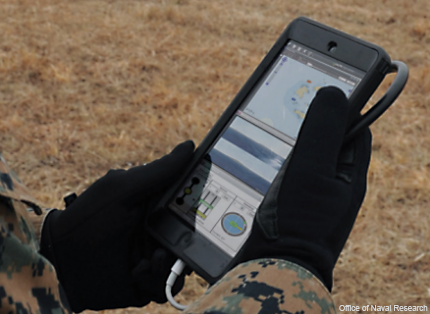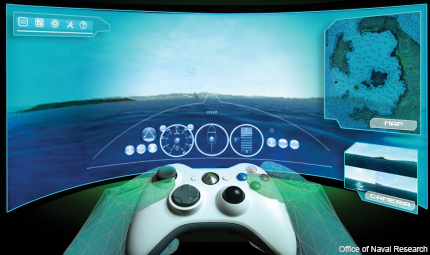Navy's widgets enable control of multiple unmanned vehicles
SSC Pacific researchers build an open-source cloud-based system that allows control of unmanned vehicles from a Web browser.

SSC Pacific's system allows control of an unmanned vehicle from a tablet, as well as other devices.
With the proliferation of unmanned vehicles, the Defense Department has been trying to simplify how they’re controlled while multiplying the number and types of vehicles that can be controller from one display. Most unmanned vehicles have dedicated, proprietary controllers, and as the number of drones in use increase, the number of controllers—and the training requirements for each one—can pile up.
One effort toward combined control is the development of a hardware-independent Unmanned Aircraft Systems (UAS) Control Services, or UCS, a kind of universal remote for unmanned aircraft. Another, being conducted at the Space and Naval Warfare Center Systems Center (SSC) Pacific in San Diego, is looking to go a step further, mixing cloud computing, open-source widgets and, in some cases, a gamepad controller to allow control of multiple types of vehicles from one source, as well as shared control of an unmanned system from land and sea locations.
The project, which was started in 2012, is called UxV to the Cloud via Widgets, with “UxV” standing for the four kinds of unmanned vehicles—air, land, sea surface and underwater. In an article earlier this year for the Office of Naval Research’s Future Force magazine, the project’s leaders outlined their progress.
At SSC Pacific, teams of experts in cloud computing, widgets and unmanned system worked together to build an open-source prototype, starting with a system for controlling an unmanned surface vehicle, or USV. The prototype combines a USV simulator, software interface for control and a widget developed with the open-source Ozone Widget Framework to provide a graphical user interface. Data from vehicles is stored in a data cloud built with the open-source Apache Accumulo software.
The cloud framework allows multiple people to control a single vessel from a Web browser, for instance passing control of a USV from a port to a ship to another ship and so on. And it allows others to view a vehicle’s images and other data. A single operator also can control multiple vehicles at a time.
In the course of development, researchers have added a few features to the interface, including the ability for an operator to view the feeds from multiple cameras on one screen, and an option to use a gamepad controller, which researchers said is a recommendation, based on usability studies, from ONR. A map widget also provides layers of navigation and other information—including historical, near real-time and live data—that can be toggled on and off, and provides a variety of zoom levels.

A single operator can control multiple vehicles shown on a map, with the option of using a gamepad controller.
Researchers said they are now working to integrate unmanned air vehicles into the system. “Operating multiple UAVs from a Web browser will provide the air community with a flexible architecture for UAV control and provide a mechanism for sharing both surface and air data among operators and analysts,” they write. They’re also working with an experimental technology called “Structure from Motion,” which uses full-motion video to build 3D models of objects within a camera’s field of view.
The prototype “has successfully demonstrated a novel approach for operating the Navy’s growing number of unmanned systems and for managing and sharing the sensor data generated by those systems,” the researchers write. Though still in development, the UxV to the Cloud via Widgets project, which is funded by the Naval Innovative Science & Engineering program, has agreements to incorporate the technology into a number of Navy programs of record for current and future technologies.



